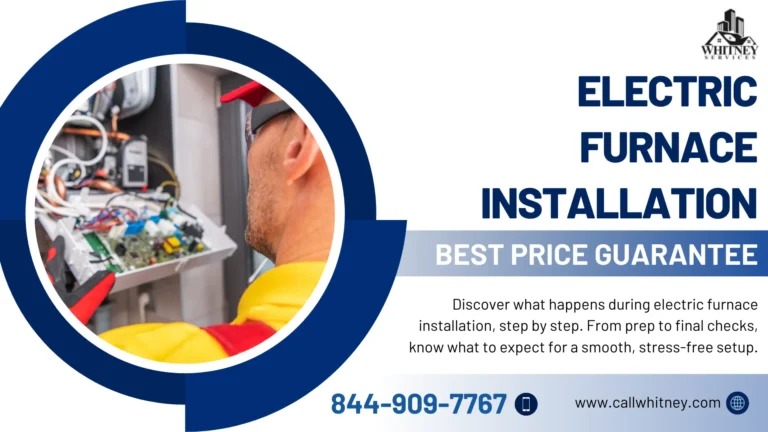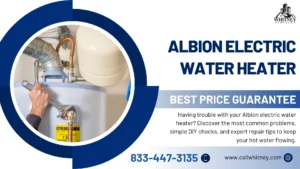When it comes to keeping your home warm and comfortable, having a reliable heating system is essential. For many homeowners, upgrading to an electric furnace is an excellent choice, especially if your current system is outdated, inefficient, or in need of frequent repairs.
At Whitney Services, we understand that the idea of electric furnace installation can feel overwhelming. From choosing the right furnace to understanding the installation process, maintenance, and costs, there’s a lot to consider. But don’t worry, we’re here to guide you every step of the way and make the entire process as smooth and stress-free as possible.
This guide will explain what to expect during electric furnace installation, how to choose the right size furnace, the costs involved, the lifespan of an electric furnace, and why working with a professional like Whitney Services is the smartest choice for your home.
Key Takeaways
- Installing an electric furnace typically ranges from $2,200 to $8,000, depending on the size, brand, and complexity of the installation. Most homeowners spend around $5,000.
- A standard installation usually takes 4 to 8 hours, though complex setups may require additional time.
- Electric furnaces can last 15 to 20 years, and in certain situations, up to 30 years, if they are properly maintained.
- Choosing the correct size furnace is crucial. For instance, a furnace with a 60,000–125,000 BTU rating is usually needed to adequately heat a 2,000 square foot house.
What is Electric Furnace Installation?
Electric furnace installation is more than just swapping out an old unit for a new one. It is a carefully planned process that ensures your home is heated efficiently and safely. Here’s what it typically involves:
Home Assessment
Before installation begins, a professional will evaluate your current heating system, ductwork, electrical setup, and the overall layout of your home. This ensures the new furnace will be compatible and provide optimal heating.
Removal of the Old Furnace
Any existing furnace, whether gas or electric, is safely disconnected and removed from your home. This step ensures there’s enough space and proper ventilation for the new unit.
Preparing the Installation Area
The space for the new furnace is prepared by clearing debris, inspecting electrical connections, and making any necessary adjustments to ductwork.
Installing the New Furnace
The furnace is positioned, integrated with the ductwork, and linked to the electrical system of your house. Every connection is carefully inspected to ensure safety and efficiency.
Testing and Calibration
Once installed, the system is thoroughly tested. This step ensures that the furnace is working properly, providing consistent heat, and running efficiently.
By the end of this process, your home will have a modern, reliable heating system designed to keep your family warm and comfortable for many years.
How Much Does Electric Furnace Installation Cost?
Cost is often one of the first concerns for homeowners considering a furnace replacement. On average, electric furnace installation costs range from $2,200 to $8,000, with most homeowners spending around $5,000.
Several factors influence the total cost:
- Type and Brand of Furnace: High-efficiency models generally have a higher upfront cost but can save you money on energy bills over time.
- Home Size: Larger homes require furnaces with higher BTU ratings, which can increase installation costs.
- Electrical System Upgrades: Older homes may need electrical updates to support the new electric furnace safely.
- Ductwork Modifications: Inefficient or outdated ductwork may require adjustments or replacement to optimize airflow and efficiency.
Although the upfront cost might seem significant, a new electric furnace is a long-term investment that provides reliable heating, energy efficiency, and comfort. Additionally, a professional installation guarantees the safety of your system and the validity of your warranty.
How Long Does It Take to Install an Electric Furnace?
Most homeowners can expect the electric furnace installation process to take approximately 4 to 8 hours. However, certain factors can extend the timeline:
- Electrical Upgrades: Homes with older electrical panels may need upgrades before the furnace can be safely installed.
- Ductwork Adjustments: If ductwork is outdated, poorly sealed, or improperly sized, modifications may be necessary.
- Tight or Hard-to-Reach Spaces: Installation may take longer if the furnace needs to be placed in a difficult-to-access location.
While it may be tempting to rush the installation, taking the necessary time ensures the furnace operates efficiently and safely, preventing potential issues in the future.
What Size Electric Furnace Do I Need?
One of the most important parts of the installation process is choosing the appropriate furnace size. A furnace that’s too small will struggle to heat your home, while a furnace that’s too large may cycle on and off too frequently, reducing efficiency and increasing wear and tear.
Based on the square footage of the house, the following is a general guideline for electric furnace sizing:
- Up to 1,200 sq. ft.: 40,000 to 60,000 BTUs
- 1,200 to 2,000 sq. ft.: 60,000 to 80,000 BTUs
- 2,000 to 3,000 sq. ft.: 80,000 to 115,000 BTUs
- 3,000+ sq. ft.: 115,000+ BTUs
Other factors, such as insulation quality, ceiling height, number of windows, and local climate, can also influence the ideal furnace size. A professional technician will perform a detailed heat load calculation to determine the correct size for your home. Choosing the right size ensures optimal comfort and energy efficiency year-round.
Is an Electric Furnace Worth It?
Electric furnaces are a popular choice for many homeowners due to their efficiency, safety, and relatively low upfront cost. Here are some benefits:
- Lower Upfront Costs: Compared to gas furnaces, electric units often cost less to purchase and install.
- Enhanced Safety: There’s no risk of gas leaks or carbon monoxide exposure.
- Low Maintenance: Over time, electric furnaces require fewer repairs because they typically have fewer moving parts than gas systems.
- Efficiency in Mild Climates: In areas with moderate winters, electric furnaces can provide highly efficient heating.
However, it’s important to consider local energy prices and climate. In colder regions, operating costs may be higher compared to gas furnaces. Despite this, for homes without existing gas lines or for homeowners seeking a safe, low-maintenance heating solution, electric furnaces are an excellent investment.
How Long Does an Electric Furnace Last?
An electric furnace can last 15 to 20 years with proper maintenance, and in some cases, even longer. Regular maintenance is crucial to extend the lifespan of your furnace and ensure it operates efficiently. This includes:
- Replacing Air Filters: Typically every 1–3 months.
- Cleaning Furnace Components: Keeping the blower and electrical components free of dust and debris.
- Annual Professional Inspection: A licensed technician can detect small issues before they become costly problems.
Investing in a high-quality electric furnace and maintaining it properly can save you money on energy bills and prevent early replacement costs.
Who Should Install an Electric Furnace?
Electric furnace installation is not a DIY project. Professional installation is critical for several reasons:
- Safety: Incorrect wiring or installation can create fire hazards or damage the system.
- Efficiency: A professional ensures your furnace runs at peak performance, saving energy and reducing utility costs.
- Warranty Compliance: In order to verify the warranty, many furnace manufacturers demand professional installation.
- Peace of Mind: You’ll have confidence that your furnace is installed correctly and safely.
At Whitney Services, our experienced technicians handle everything from sizing and installation to testing and calibration, ensuring your home stays warm and safe from day one.
Why Choose Whitney Services?
At Whitney Services, we don’t just install furnaces, we provide comprehensive heating services that prioritize your comfort and peace of mind.
Here’s why homeowners trust us:
- Years of Experience: Our staff has a great deal of experience installing and replacing electric furnaces.
- Transparent Pricing: There are no additional costs associated with our upfront, transparent pricing.
- Customer Satisfaction: We make sure every installation meets your needs and exceeds your expectations.
- Full-Service Support: From installation to maintenance and repair, we’re here to care for your home’s heating system.
- Best Price Promise: We will match or beat competitors’ prices without compromising quality.
Whether you’re installing a furnace in a new home or replacing an old unit, Whitney Services makes the process seamless, efficient, and stress-free.
Conclusion
Investing in an electric furnace installation is a smart decision for homeowners who want reliable, safe, and efficient heating. From understanding costs and sizing to professional installation and ongoing maintenance, there’s a lot to consider—but you don’t have to navigate it alone.
You can be sure that your installation will be completed correctly, safely, and efficiently by working with experts like Whitney Services. A modern electric furnace isn’t just a heating system, it’s a long-term investment in your home’s comfort, energy efficiency, and peace of mind.
No matter the size of your home or your heating needs, Whitney Services is here to guide you every step of the way. With our expertise, dedication, and commitment to quality, you can rest easy knowing your home will stay warm and cozy for years to come.
Frequently Asked Questions
Common signs include frequent repairs, inconsistent heating, unusual noises, or a furnace that is older than 15 years.
Professional installation is strongly recommended for safety, efficiency, and warranty compliance.
At least once a year, ideally before the heating season begins. Your furnace’s lifespan is increased with routine maintenance.
In colder climates, yes. However, in places with milder temperatures or in homes without gas lines, electric furnaces may be less expensive.
Contact a licensed HVAC technician immediately to diagnose and repair the issue.







